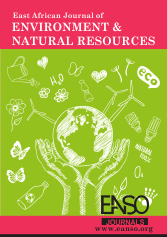Impact of Climate Change on Water Resources and its Implications on Biodiversity: A Review
الملخص
Climate change-related impacts on water resources can significantly lead to biodiversity loss. Species with specific water resource adaptations, including threatened and endemic species, are in danger of going extinct. The effect of climate change on biodiversity related to water scarcity or shortages has received less attention despite being acknowledged. This paper provides up-to-date collective information and knowledge gap on the impact of climate change on water and how it impacts biodiversity with a particular focus on the connection between climate change impacts, water resources, and the species biodiversity. Sixty (60) original peer reviewed research or review articles, and reports were reviewed to highpoint the impact of climate change on water resources and its implications on biodiversity including human being. We highlight that the impact of climate change on water resources (e.g., water scarcity and shortages) exerts more pressure on biodiversity conservation as it directly affects the growth and behaviour of species and modifies their habitats, population size, composition, interactions, timing of reproduction, reproductive phenology, and growing season. Furthermore, being the part of earth’s biodiversity, humans are also affected by the climate change water-related problems. This review earmarked that water shortages due to climate change puts the human population at great risk in terms of crop productivity, food security, and a variety of economic activities. Well–designed infrastructure to harvest water, mitigate and adapt to climate change is vital for protecting biodiversity from climate risks i.e., water shortages. This review paper is useful to government agencies charged with climate change and environmental conservation and policymakers mostly in developing nations to widen goals where the impact of climate is more noticeable. In addition, several deaths of animals and human due to water shortages have been reported.
التنزيلات
المراجع
Agnes, E., Matchawe, C., & Nsawir, B.J. (2021). The use of alternative water sources as a means of adaptation to water shortages in Nsimeyong, Yaounde city: A quality assessment. Scientific African, 13.
Boone, W.W., & McCleery, R.A. (2023). Climate change likely to increase co-occurrence of island endemic and invasive wildlife. Climate Change Ecology 4, 100061. https://doi.org/10.1016/j.ecochg.2022.100061
Brown, G.S., Pollock, L., DeWitt, P.D., & Dawson, N. (2020). Responses of terrestrial animals to forest characteristics and climate reveals ecological indicators for sustaining wildlife in managed forests. Forest Ecology and Management 459, 117854. https://doi.org/10.1016/j.foreco.2019.117854
Burek, P., Satoh, Y., & Fischer, G., 2016. Water futures and solution: Fast track initiative – final report (ADA Project No. 2725-00/2014). International Institute for Applied Systems Analysis, Laxenburg, Austria
Caten, C.T., Lima-Ribeiro, M. de S., da Silva, N.J., Moreno, A.K., & Terribile, L.C. (2017). Evaluating the Effectiveness of Brazilian Protected Areas Under Climate Change: A Case Study of Micrurus brasiliensis (Serpentes: Elapidae). Tropical Conservation Science 10, 194008291772202. https://doi.org/10.1177/1940082917722027
Chhaytle, M., Ouvrard, R., & Poinot, T. (2022). New population dynamics models to evaluate the climate impacts on wildlife populations. IFAC-PapersOnLine 55 (5), 54–59. https://doi.org/10.1016/j.ifacol.2022.07.639
Coffinet, S., Huguet, A., Bergonzini, L., Pedentchouk, N., Williamson, D., Anquetil, C., Gałka, M., Kołaczek, P., Karpińska-Kołaczek, M., Majule, A., Laggoun-Défarge, F., Wagner, T., & Derenne, S. (2018). Impact of climate change on the ecology of the Kyambangunguru crater marsh in southwestern Tanzania during the Late Holocene. Quaternary Science Reviews 196, 100–117. https://doi.org/10.1016/j.quascirev.2018.07.038
Crosmary, W.-G., Valeix, M., Fritz, H., Madzikanda, H., & Côté, S.D. (2012). African ungulates and their drinking problems: hunting and predation risks constrain access to water. Animal Behaviour 83, 145–153. https://doi.org/10.1016/j.anbehav.2011.10.019
Cui, Q., & Corlett, R.T. (2016). Seasonal and diurnal patterns of activity in honeybees ( Apis spp.) on the northern edge of the Asian tropics; their implications for the climate-change resilience of pollination. Tropical Conservation Science 9, 194008291666714. https://doi.org/10.1177/1940082916667142
Dueñas, A., Jiménez-Uzcátegui, G., & Bosker, T. (2021). The effects of climate change on wildlife biodiversity of the galapagos islands. Climate Change Ecology 2, 100026. https://doi.org/10.1016/j.ecochg.2021.100026
Eguiguren-Velepucha, P.A., Chamba, J.A.M., Aguirre Mendoza, N.A., Ojeda-Luna, T.L., Samaniego-Rojas, N.S., Furniss, M.J., Howe, C., & Aguirre Mendoza, Z.H. (2016). Tropical ecosystems vulnerability to climate change in southern Ecuador. Tropical Conservation Science 9, 194008291666800. https://doi.org/10.1177/1940082916668007
Eisemberg, C.C., Machado Balestra, R.A., Famelli, S., Pereira, F.F., Diniz Bernardes, V.C., & Carl Vogt, R. (2016). Vulnerability of Giant South American Turtle (Podocnemis expansa) nesting habitat to climate-change-induced alterations to fluvial cycles. Tropical Conservation Science 9, 194008291666713. https://doi.org/10.1177/1940082916667139
El-Fakharany, Z.M., & Salem, M.G. (2021). Mitigating climate change impacts on irrigation water shortage using brackish groundwater and solar energy. Energy Reports 7, 608–621. https://doi.org/10.1016/j.egyr.2021.07.091
Engelbrecht, F., Adegoke, J., Bopape, M.-J., Naidoo, M., Garland, R., Thatcher, M., McGregor, J., Katzfey, J., Werner, M., Ichoku, C., & Gatebe, C. (2015). Projections of rapidly rising surface temperatures over Africa under low mitigation. Environ. Res. Lett. 10, 085004. https://doi.org/10.1088/1748-9326/10/8/085004
Ferry, N., Cordonnier, M., Hulot, F.D., Dakwa, F., Sebele, L., Dray, S., Fritz, H., & Valeix, M. (2020). Heterogeneity of water physico-chemical characteristics in artificially pumped waterholes: do African herbivores drink at the same locations and does it lead to interference competition? Journal of Arid Environments 173, 104014. https://doi.org/10.1016/j.jaridenv.2019.104014
Fonseca, A. (2022). Tackling climate change impacts on biodiversity towards integrative conservation in Atlantic landscapes. Global Ecology and Conservation 19.
Gonçalves, F. (2021). Combined impacts of climate and land use change and the future restructuring of Neotropical bat biodiversity. Perspectives in Ecology and Conservation 10.
Habibullah, M.S., Din, B.H., Tan, S.-H., & Zahid, H. (2022). Impact of climate change on biodiversity loss: global evidence. Environ Sci Pollut Res 29, 1073–1086. https://doi.org/10.1007/s11356-021-15702-8
Hou, C., Wen, Y., Liu, X., & Dong, M. (2021). Impacts of regional water shortage information disclosure on public acceptance of recycled water — evidences from China’s urban residents. Journal of Cleaner Production, 278, 1239-1265.
Hulme, P.E., Burslem, D.F.R.P., Dawson, W., Edward, E., Richard, J., & Trevelyan, R. (2013). Aliens in the Arc: Are Invasive Trees a Threat to the Montane Forests of East Africa? in: Foxcroft, L.C., Pyšek, P., Richardson, D.M., Genovesi, P. (Eds.), Plant Invasions in Protected Areas. Springer Netherlands, Dordrecht, pp. 145–165. https://doi.org/10.1007/978-94-007-7750-7_8
Hunninck, L., May, R., Jackson, C.R., Palme, R., Røskaft, E., & Sheriff, M.J. (2020). Consequences of climate-induced vegetation changes exceed those of human disturbance for wild impala in the Serengeti ecosystem. Conservation Physiology 8, coz117. https://doi.org/10.1093/conphys/coz117
John, E., Bunting, P., Hardy, A., Roberts, O., Giliba, R., & Silayo, D.S. (2020). Modelling the impact of climate change on Tanzanian forests. Divers Distrib 26, 1663–1686. https://doi.org/10.1111/ddi.13152
Kummu, M., Guillaume, J.H.A., & Moel, H. (2016). The world’s road to water scarcity: Shortage and stress in the 20th century and pathways towards sustainability. Scientific Reports, 6, 384-3895.
Leal Filho, W. (2019). Handling the Impacts of Climate Change on Biodiversity, in: Filho, W., Barbir, J., Preziosi, R. (Eds.), Handbook of Climate Change and Biodiversity, Climate Change Management. Springer International Publishing, Cham, pp. 403–408. https://doi.org/10.1007/978-3-319-98681-4_25
Loarie, S.R., Aarde, R.J.V., & Pimm, S.L. (2009). Fences and artificial water affect African savannah elephant movement patterns. Biological Conservation 142, 3086–3098. https://doi.org/10.1016/j.biocon.2009.08.008
McCluney, K.E., Belnap, J., Collins, S.L., Gonzalez, A.L., Hagen, E.M., Holland, J.N., Kotler, B.P., Maestre, F.T., Smith, S.D., & Wolf, B.O. (20110). Shifting species interactions in terrestrial dryland ecosystems under altered water availability and climate change. Biological Reviews 20.
Meng, H., Carr, J., Beraducci, J., Bowles, P., Branch, W.R., Capitani, C., Chenga, J., Cox, N., Howell, K., Malonza, P., Marchant, R., Mbilinyi, B., Mukama, K., Msuya, C., Platts, P.J., Safari, I., Spawls, S., Shennan-Farpon, Y., Wagner, P., Burgess, N.D. (2016). Tanzania’s reptile biodiversity: Distribution, threats and climate change vulnerability. Biological Conservation 204, 72–82. https://doi.org/10.1016/j.biocon.2016.04.008
Meng, S., & Xiong, D. (2018). Review and Exploration of China Subtropical Climate Change Research Based on Scientometric Analysis. Tropical Conservation Science 11, 194008291880679. https://doi.org/10.1177/1940082918806795
Mkiramweni, N.P., DeLacy, T., Jiang, M., & Chiwanga, F.E. (2016). Climate change risks on protected areas ecotourism: shocks and stressors perspectives in Ngorongoro Conservation Area, Tanzania. Journal of Ecotourism 15, 139–157. https://doi.org/10.1080/14724049.2016.1153645
Moullec, F. (2022). Using species distribution models only may underestimate climate change impacts on future marine biodiversity. Ecological Modelling 11.
Muluneh, M.G. (2021). Impact of climate change on biodiversity and food security: a global perspective—a review article. Agric & Food Secur 10, 36. https://doi.org/10.1186/s40066-021-00318-5
Mwabumba, M. (2022). Rainfall and temperature changes under different climate scenarios at the watersheds surrounding the Ngorongoro Conservation Area in Tanzania. Environmental Challenges 13.
Numata, S., Yamaguchi, K., Shimizu, M., Sakurai, G., Morimoto, A., Alias, N., Noor Azman, N.Z., Hosaka, T., & Satake, A. (2022). Impacts of climate change on reproductive phenology in tropical rainforests of Southeast Asia. Commun Biol 5, 1–10. https://doi.org/10.1038/s42003-022-03245-8
Nunez, S., Arets, E., Alkemade, R., Verwer, C., & Leemans, R. (2019). Assessing the impacts of climate change on biodiversity: is below 2 °C enough? Climatic Change 154, 351–365. https://doi.org/10.1007/s10584-019-02420-x
Nyembo, L.O., Larbi, I., Mwabumba, M., Selemani, J.R., Dotse, S.-Q., Limantol, A.M., & Bessah, E. (2022). Impact of climate change on groundwater recharge in the lake Manyara catchment, Tanzania. Scientific African 15, e01072. https://doi.org/10.1016/j.sciaf.2021.e01072
O’Connell-Rodwell, C.E., Wood, J.D., Kinzley, C., Rodwell, T.C., Alarcon, C., Wasser, S.K., Sapolsky, R. (2011). Male African elephants (Loxodonta africana) queue when the stakes are high. Ethology Ecology & Evolution 23, 388–397. https://doi.org/10.1080/03949370.2011.598569
Ojija, F., Abihudi, S., Mwendwa, B., Leweri, C.M., & Chisanga, K. (2017). The Impact of Climate Change on Agriculture and Health Sectors in Tanzania: A review. IJEAB 2, 1758–1766. https://doi.org/10.22161/ijeab/2.4.37
Ornelas, J.F., Licona-Vera, Y., & Vásquez-Aguilar, A.A. (2018). Genetic Differentiation and Fragmentation in Response to Climate Change of the Narrow Endemic Psittacanthus auriculatus. Tropical Conservation Science 11, 194008291875551. https://doi.org/10.1177/1940082918755513
Pacheco, S., Malizia, L.R., & Cayuela, L. (2010). Effects of Climate Change on Subtropical Forests of South America. Tropical Conservation Science 3, 423–437. https://doi.org/10.1177/194008291000300407
Pearce, D.A. (2008). Climate Change and the Microbiology of the Antarctic Peninsula Region. Science Progress 91, 203–217. https://doi.org/10.3184/003685008X332534
Périquet, S., Fritz, H., Revilla, E., Macdonald, D.W., Loveridge, A.J., Mtare, G., & Valeix, M. (2021). Dynamic interactions between apex predators reveal contrasting seasonal attraction patterns. Oecologia 195, 51–63. https://doi.org/10.1007/s00442-020-04802-w
Prato, T. (2009). Evaluating and managing wildlife impacts of climate change under uncertainty. Ecological Modelling 220, 923–930. https://doi.org/10.1016/j.ecolmodel.2009.01.010
Rhodes, C.J. (2019). Only 12 years left to readjust for the 1.5-degree climate change option – Says International Panel on Climate Change report: Current commentary. Science Progress 102, 73– 87. https://doi.org/10.1177/0036850418823397
Rhodes, C.J. (2014). Soil Erosion, Climate Change and Global Food Security: Challenges and Strategies. Science Progress 97, 97–153. https://doi.org/10.3184/003685014X13994567941465
Rose, H., Hoar, B., Kutz, S.J., Morgan, E.R. (2014). Exploiting parallels between livestock and wildlife: Predicting the impact of climate change on gastrointestinal nematodes in ruminants. International Journal for Parasitology: Parasites and Wildlife 3, 209–219. https://doi.org/10.1016/j.ijppaw.2014.01.001
Salehi, M. (2022). Global water shortage and potable water safety; Today’s concern and tomorrow’s crisis. Environment International 158, 106936. https://doi.org/10.1016/j.envint.2021.106936
Sintayehu, D.W., 2018. Impact of climate change on biodiversity and associated key ecosystem services in Africa: a systematic review. Ecosystem Health and Sustainability 4, 225–239. https://doi.org/10.1080/20964129.2018.1530054
Sternberg, M., Gabay, O., Angel, D., Barneah, O., Gafny, S., Gasith, A., Grünzweig, J.M., Hershkovitz, Y., Israel, A., Milstein, D., Rilov, G., Steinberger, Y., & Zohary, T. (2015). Impacts of climate change on biodiversity in Israel: an expert assessment approach. Reg Environ Change 15, 895–906. https://doi.org/10.1007/s10113-014-0675-z
Sushant. (2013). Impact of Climate Change in Eastern Madhya Pradesh, India. Tropical Conservation Science 6, 338–364. https://doi.org/10.1177/194008291300600304
Talukder, B. (2022). Climate change-accelerated ocean biodiversity loss & associated planetary health impacts 12.
Taylor, S., Kumar, L. (2016). Global Climate Change Impacts on Pacific Islands Terrestrial Biodiversity: A Review. Tropical Conservation Science 9, 203–223. https://doi.org/10.1177/194008291600900111
Tietjen, B., Jeltsch, F., Zehe, E., Classen, N., Groengroeft, A., Schiffers, K., & Oldeland, J. (2009). Effects of climate change on the coupled dynamics of water and vegetation in drylands. Ecohydrol. n/a-n/a. https://doi.org/10.1002/eco.70
Trinkel, M., Fleischmann, P.H., Steindorfer, A.F., Kastberger, G. (2004). Spotted hyenas ( Crocuta crocuta ) follow migratory prey. Seasonal expansion of a clan territory in Etosha, Namibia. Journal of Zoology 264, 125–133. https://doi.org/10.1017/S0952836904005588
Tsalyuk, M., Kilian, W., Reineking, B., & Getz, W.M. (2019). Temporal variation in resource selection of African elephants follows long‐term variability in resource availability. Ecol Monogr 89. https://doi.org/10.1002/ecm.1348
Turner, W.C., Périquet, S., Goelst, C.E., Vera, K.B., Cameron, E.Z., Alexander, K.A., Belant, J.L., Cloete, C.C., du Preez, P., Getz, W.M., Hetem, R.S., Kamath, P.L., Kasaona, M.K., Mackenzie, M., Mendelsohn, J., Mfune, J.K.E., Muntifering, J.R., Portas, R., Scott, H.A., Strauss, W.M., Versfeld, W., Wachter, B., Wittemyer, G., Kilian, J.W. (2022). Africa’s drylands in a changing world: Challenges for wildlife conservation under climate and land-use changes in the Greater Etosha Landscape. Global Ecology and Conservation 38, e02221. https://doi.org/10.1016/j.gecco.2022.e02221
UNICEF, WHO. (2019) Progress on drinking water, sanitation and hygiene: 2000–2017: special focus on inequalities. Accessed on November 30, 2022, https://data.unicef.org/resources/progress-drinking-water-sanitation-hygiene-2019/. Google Scholar
Valeix, M., Fritz, H., Matsika, R., Matsvimbo, F., &Madzikanda, H. (2008). The role of water abundance, thermoregulation, perceived predation risk and interference competition in water access by African herbivores. African Journal of Ecology 46, 402–410. https://doi.org/10.1111/j.1365-2028.2007.00874.x
Valeix, M., Loveridge, A.J., Davidson, Z., Madzikanda, H., Fritz, H., Macdonald, D.W., (2010). How key habitat features influence large terrestrial carnivore movements: waterholes and African lions in a semi-arid savanna of north-western Zimbabwe. Landscape Ecol 25, 337–351. https://doi.org/10.1007/s10980-009-9425-x
Vásquez-Aguilar, A.A., Ornelas, J.F., Rodríguez-Gómez, F., Cristina MacSwiney G., M., (2021). Modeling Future Potential Distribution of Buff-Bellied Hummingbird (Amazilia yucatanensis) Under Climate Change: Species vs. Subspecies. Tropical Conservation Science 14, 194008292110308. https://doi.org/10.1177/19400829211030834
Wiig, Ø., Aars, J., & Born, E.W. (2008). Effects of Climate Change on Polar Bears. Science Progress 91, 151–173. https://doi.org/10.3184/003685008X324506
Kundzewicz, Zbigniew W. (2008). Climate change impacts on the hydrological cycle. Ecohydrology & Hydrobiology, 8(2-4), 195–203. doi:10.2478/v10104-009-0015-y
الحقوق الفكرية (c) 2023 Fredrick Ojija, Regan Nicholaus

هذا العمل مرخص حسب الرخصة Creative Commons Attribution 4.0 International License.




























